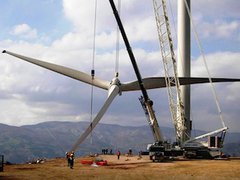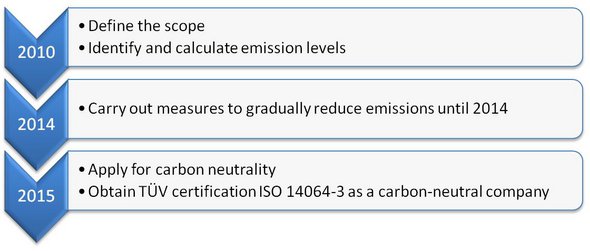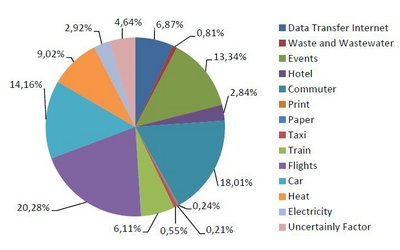
In the past months, we have focused on gearing our company’s environmental protection measures to achieving the target of becoming carbon neutral. Following the decision to launch this project in early 2010, we were eager to find out whether a service provider and software vendor like AMPEG could afford to achieve carbon neutral certification.
We also wanted to check the impact of the measures we had already taken to reduce our carbon emissions.
Project planning
The carbon neutrality project was planned to run for a period of 5 years. The milestones defined in the project planning consisted of reducing AMPEG’s emissions step by step until the year 2014, and then to apply for carbon neutral certification for the first time in 2015.
AMPEG commissioned a consultancy to help define the scope of its GHG inventory and to calculate its emission levels. The consultancy was also tasked with identifying potential for cutting carbon emissions at AMPEG down to a level at which carbon neutrality can be achieved.
Scope – Defining the scope
To define the scope for calculating its carbon footprint, AMPEG selected an internationally recognised scope classification system. This classification was developed by the accounting tool “Greenhouse Gas Protocol (GHG Protocol)” in cooperation with many others partners, such as the World Resources Institute and the World Business Council for Sustainable Development (WBCSD), and has become an international standard in carbon accounting.
Defining the scope is the first step in carbon accounting. Here, a decision is made about the scope of emissions to be recorded and the threshold under which they can be ignored. Three main categories have been set up, ranging from Scope 1 to Scope 3.
• Scope 1: Covers emissions that are caused directly by the company,
for example at its production sites.
• Scope 2: Covers significantly more: In addition to the Scope 1 emissions,
it also includes the emissions caused by purchased energy.
• Scope 3: Also includes emissions caused by purchased third-party services.
As an IT service provider and software vendor, AMPEG has no Scope 1 emissions, so we decided to cover as many emissions from Scopes 2 and 3 as possible. Industrial enterprises, on the other hand, would first have to focus on reducing and neutralising their Scope 1 emissions.
Once the scope had been defined, it was necessary to decide which emissions within this scope would be taken into account and which would not. Calculating emission levels for energy consumption, mobility and paper consumption proved relatively simple and fast. Factors such as office equipment were not taken into account because it would have been much too complex and time-consuming to calculate the emission levels of the individual pieces of equipment. There are no empirical values and manufacturer data available so far for purchased office equipment.
The carbon footprint: Calculating the GHG inventory
In the next step, the consultancy defined the greenhouse gas (GHG) inventory, which includes not only CO2 but also CO2 equivalents (CH4, N2O, HFC, PFC, SF6). In 2010, the emission levels were calculated for the preceding financial year. Carbon neutrality can only be ascertained retrospectively.
In order to make the necessary calculations, AMPEG had to provide the consultancy with information on service charge costs, the amounts of paper consumed, all employee travel data, etc. The AMPEG staff were asked to fill out questionnaires providing information on the distance and the way they travel to work so that we could take commuting distances into account.
The results were surprisingly positive both for the consultancy that had calculated the inventory and for AMPEG. The measures that AMPEG had carried out in the last few years to reduce its electricity consumption certainly paid off. As the company had additionally switched to exclusively using electricity from renewable sources, electricity emissions only account for 2.92% of total emissions. The proportions of the individual sources of emissions are shown in the chart below.
Difficulties in making the calculations
In the end, it wasn’t all that easy to obtain the final results after all. When AMPEG received the first results, Peter Graf, managing director of AMPEG GmbH, immediately noticed that internet data traffic had not been included in the calculations. In response to his enquiry about this, the consultancy said that there was no factor for calculating the carbon emissions caused by internet data traffic and that they had no experience in this respect. Further enquiries with TÜV Rheinland did not help either, as they too said that they had no experience in this matter and therefore had no basis for calculating these emissions.
But Peter Graf wasn’t going to give up that easily: he was adamant that internet data traffic should be included as it is a key part of AMPEG’s business operations. AMPEG therefore commissioned the consultancy to calculate a factor for this purpose. After evaluating existing research, a factor was defined to measure the carbon emissions per Mbyte of internet data volume. This factor can now be used not just by AMPEG but also by the consultancy’s future customers.
The work involved in making this calculation was very worthwhile, as is shown by the result: internet data traffic accounts for 6.87% of the total inventory. This is definitely a source of emissions that is worth including in calculating AMPEG’s total emissions.
Carbon footprint reduction measures
The calculation of AMPEG’s carbon footprint showed that there was, above all, potential to cut mobility-related emissions by reducing flights and car travel. By then, car travel to and from work had already been reduced as the office premises had moved to Bremen city centre, so more staff were travelling to work by bicycle or by public transport.
We also wanted to reduce the flights factor, which accounted for more than 20% of greenhouse gas emissions. Measures were taken as early as 2011 to reduce these emissions. It was clear that air travel had to be reduced as much as possible. In order to encourage staff to travel by train, the company purchased a Bahncard 100 for the relevant staff members (this card entitles its holder to one year’s travel on the entire German rail network). The Bahncard 100 also makes economic sense, as the company no longer has to pay for expensive domestic flights.
Offsetting emissions with certificates: Achieving carbon neutrality
The next and final step in making a company carbon neutral is to offset the calculated level of emissions by purchasing carbon emissions certificates. These certificates are generated either when greenhouse gas emissions are reduced elsewhere or through reforestation projects. The idea is that trees planted in the reforestation projects will capture CO2 from the atmosphere. The CO2 certificates must then be retired in order for the company to become carbon neutral.

Certificates are available in a whole range of standards. AMPEG opted for the Gold Standard. To classify as Gold Standard, the certificates have to come from a project that is not just designed to reduce carbon emissions but also contributes to the social, ecological and economic development of the area it is located in. Only those projects that meet the highest standards and have the same objectives as the Clean Development Mechanism defined in the Kyoto Protocol are awarded the Gold Standard. The Gold Standard certificates are thus more expensive than the other standards.
AMPEG purchased and retired carbon credits generated by a wind farm in Yuntdag, Turkey. The wind park has been a registered Gold Standard project since July 2008.
ISO 14064-3 certification through TÜV Rheinland achieved in 2011
Once the purchased certificates had been retired, AMPEG was certified as carbon neutral by TÜV Rheinland. All the project documentation was submitted to TÜV Rheinland for review. TÜV Rheinland spotted an error in the calculations, but it only had a marginal impact on the results and was actually in AMPEG GmbH’s favour, slightly improving its GHG inventory.
AMPEG is now also included in the TÜV file. The certificate can be viewed online at http://www.tuvdotcom.com with the ID: 0000031898.
- Calculated carbon footprint
- Carbon-neutral company
- Regular auditing
Conclusion
Below, I would like to summarise the main steps to becoming carbon neutral:
• Calculation of the corporate carbon footprint retroactively for the last financial year
• Further measures to cut emissions, if necessary
• Purchase of certificates to offset the greenhouse gas emissions
• Certification as per ISO 14064-3 by TÜV Rheinland
The costs for the whole project including the work on the project carried out by AMPEG internally only amounted to 0.28% of its 2010 annual revenue. The company was able to become carbon neutral with only a very marginal impact on its operating results.
We were very pleased with the project. The plan was for the company to become carbon neutral from 2015 and, on account of the excellent previous efforts to reduce carbon emissions, we were able to achieve carbon neutrality as early as 2011. For a company that provides services and produces software it is really very simple and inexpensive to become carbon neutral.


